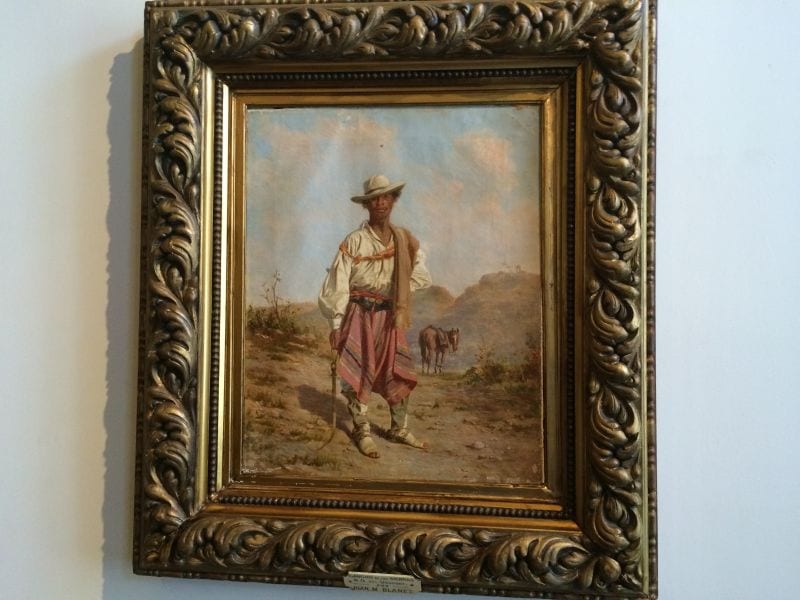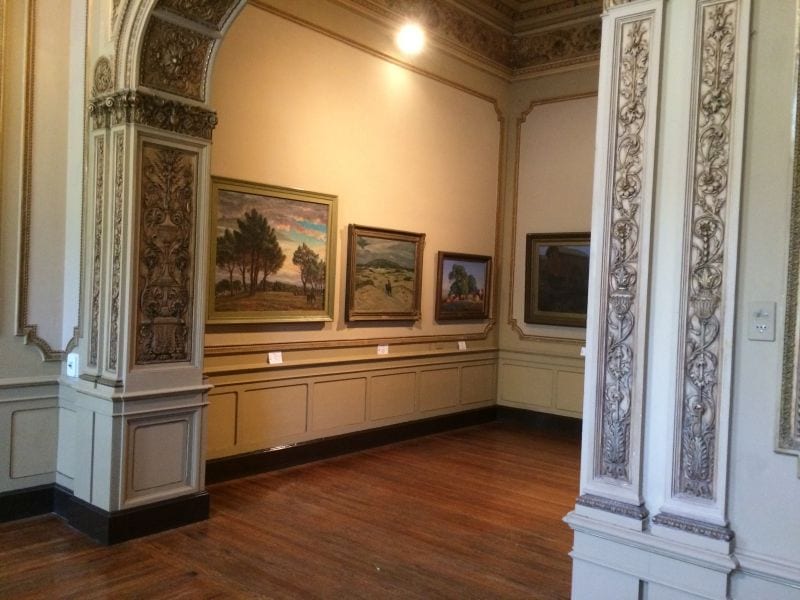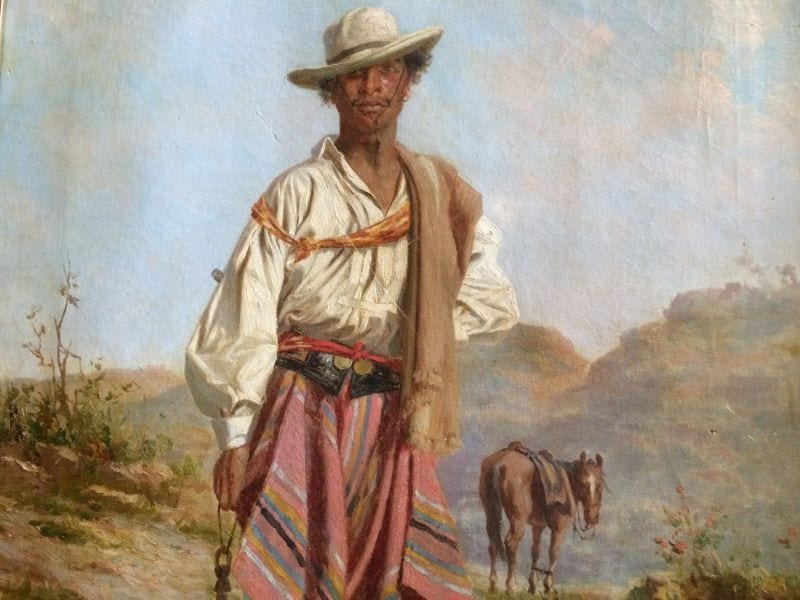One of the first things I pick up in a new place is a local map.
I find main streets, find plazas, find the river, find the bus terminal or airport, a good place to eat, the farmacia, and someone who knows a little English if I get in a jam. The map the hotel gives me is called the “Plano Urbano de Salto.” One of the things to see close to where I’m staying is the Museo of Bella Arts.
This museum was once a huge home belonging to the woman whose portrait is on the wall when you first enter. The pink colored house is on Uruguay street and is open, free of charge, to anyone who wishes to see inside. Entering the museum, you see that the lady collected art, and, when she passed, left the house and art as her memorial.
One of the smaller, and maybe least ostentatious paintings, is of a gaucho.
In this oil painting, a solitary gaucho poses for his portrait while his horse looks back at him and waits for marching orders.
ThIs cowpoke travels light, has his bedroll and jerky and saddlebags, wears loose fitting and comfortable clothes, and looks ready for anything. Out in the wilderness, alone, he has to solve problems and is reliant on his wits, his experience, and horse to get him through dangerous times.
Being a gaucho must be a little like being a soldier in war. You have days and days of boredom and waiting punctuated with brief episodes of stark terror when bullets fly past your head, and any one of them could send you where you don’t want to go.
Gauchos and cowboys are something that Uruguay and the United States used to have in common.
However, it is hard to see how two countries who admire self reliance and the pioneer spirit have done so much to stamp it out.
The only place we see wild spirits now Is on television and in movies.
Search The Site
Translate This Page
Support Scott
See Scott’s Artwork!
Your purchase helps Scott continue his travels and he’ll reciprocate by taking you along in words, photos and videos!Recent Posts
Recent Comments
- scott on Fishing/Palo Duro Canyon
- rhett ladd on Fishing/Palo Duro Canyon
- scott on Strawberry Shortcake
- Charlie on Strawberry Shortcake
- scott on Prepper Money
- Alan on Prepper Money
- scott on Decorative Art
Archives
- April 2020 (28)
- November 2019 (1)
- October 2019 (5)
- September 2019 (3)
- August 2019 (8)
- July 2019 (18)
- June 2019 (8)
- May 2019 (21)
- March 2019 (52)
- February 2019 (22)
- November 2018 (18)
- October 2018 (9)
- August 2018 (1)
- July 2018 (10)
- June 2018 (11)
- December 2017 (11)
- August 2017 (12)
- June 2017 (18)
- April 2017 (10)
- March 2017 (33)
- February 2017 (33)
- January 2017 (2)
- October 2016 (2)
- September 2016 (49)
- June 2016 (1)
- March 2016 (2)
- February 2016 (8)
- January 2016 (16)
- December 2015 (50)
- November 2015 (57)
- October 2015 (7)
- September 2015 (10)
- August 2015 (11)
- July 2015 (5)
- June 2015 (6)
- May 2015 (8)
- April 2015 (6)
- March 2015 (8)
- January 2015 (29)
- December 2014 (30)
- November 2014 (83)
- October 2014 (3)
Categories
- Country (423)
- Belize (57)
- Costa Rica (10)
- Dominican Republic (55)
- Ecuador (56)
- Haiti (18)
- Mexico (48)
- Nicaragua (51)
- Philippines (30)
- Uruguay (98)
- Photo Shoots (10)
- Scott's Best Of (713)
- Animal Stories (86)
- Art, Music, Performance, Writing (122)
- Blast to the Past (111)
- Fish Stories (28)
- Friends & Family (88)
- Getting Around (81)
- Holidays, Events & Celebrations (50)
- Home Bases (69)
- Kids (47)
- Money Talk (118)
- Mother Nature Saddles Up (106)
- On the Beach (49)
- People (214)
- Places to Go & Things to See (185)
- Quirky (134)
- Shop 'til You Drop (57)
- Spirit Talks (194)
- Sports & Recreation (75)
- The Great Security State (108)
- What's to Eat (125)
- Working For a Living (154)
- States (293)
- Arizona (48)
- California (6)
- Colorado (36)
- Florida (10)
- Nebraska (6)
- New Mexico (150)
- Texas (37)
- Videos (66)






Like the gaucho painting!